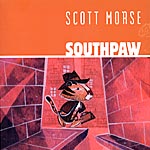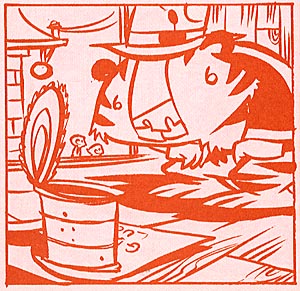 By Scott Morse
By Scott Morse
128 pages, orange and white
Published by AdHouse Books
Some of the best “all-ages” books are ones that have different appeals to different ages, while still being enjoyable. As a child, you can read and enjoy the book on a very simple level. As an adult, you might see more to the story, an added level of understanding and recognition. It’s great because you can keep reading the book throughout your life, always enjoying what you picked up on early read-throughs, but still finding more lurking beneath the surface just waiting to be discovered. That, to me, is one of the big appeals of Scott Morse’s Southpaw.
Southpaw is a tiger, one who boxes against robots to make ends meet. When Southpaw’s robot manager tells him to throw the match in the fifth round as part of a fixed result, Southpaw ends up knocking Robolobo’s head off its block and then has to run for the hills. Now everyone’s looking for Southpaw, curious bystanders and vengeance-seeking robots alike. How long can Southpaw keep running?
On its absolute surface, Southpaw is a fun little story about a tiger on the run from robots. On that level alone, Southpaw succeeds. It’s almost set up in little episodes, between the boxing, and the train, and the diner scenes. It’s an easy basic story about being on the run, and it’s certainly enjoyable just on that level. What I really liked, though, was the questions of what you have to give up in order to stand up for your own principles, and at what point you have to stop running from your problems. They’re questions that I think as adults just about everyone has had to think about, and I appreciate Morse’s weaving of these questions into the narration. There aren’t easy answers presented here, and the ending is one that lets you draw your own conclusion as to what happened.
 Morse’s art in Southpaw reminds me a bit of some of his earlier art, like in Volcanic Revolver. Maybe it’s because of the setting, with its brick buildings and seedy alleyways. Maybe it’s because each page is a single panel, so he’s really able to get into the details of the surroundings to help make each location feel like its own character. Maybe it’s the snazzy hat and jacket that Southpaw wears as he walks around town. (He’s the best-dressed tiger you’ve ever met!) Whatever the reason, I like it. Southpaw isn’t the only good character design here, mind you. The robots of Southpaw look like they were cobbled together by people in our world, with great retro stylings coupled with a feeling that these are actual machines, not magical beings that just somehow work. It helps really ground Southpaw in reality… well, as much reality as a book about a tiger who boxes robots for money can have, I guess. As an added bonus, each page is published in orange and white, which gives Southpaw its own visual identity as well as just being pretty darn cute.
Morse’s art in Southpaw reminds me a bit of some of his earlier art, like in Volcanic Revolver. Maybe it’s because of the setting, with its brick buildings and seedy alleyways. Maybe it’s because each page is a single panel, so he’s really able to get into the details of the surroundings to help make each location feel like its own character. Maybe it’s the snazzy hat and jacket that Southpaw wears as he walks around town. (He’s the best-dressed tiger you’ve ever met!) Whatever the reason, I like it. Southpaw isn’t the only good character design here, mind you. The robots of Southpaw look like they were cobbled together by people in our world, with great retro stylings coupled with a feeling that these are actual machines, not magical beings that just somehow work. It helps really ground Southpaw in reality… well, as much reality as a book about a tiger who boxes robots for money can have, I guess. As an added bonus, each page is published in orange and white, which gives Southpaw its own visual identity as well as just being pretty darn cute.
Southpaw is another gorgeous-looking book from AdHouse Books, and the actual contents match up to the snazzy production values. With its 6×6″ dimensions, special ink colors, endflaps, and a gorgeous four-panel wrap-around painted cover, Southpaw knocks the competition out of the ring. It’s a really fun book and I think it’s a worthy addition to just about anyone’s comic book library.
Purchase Links:
